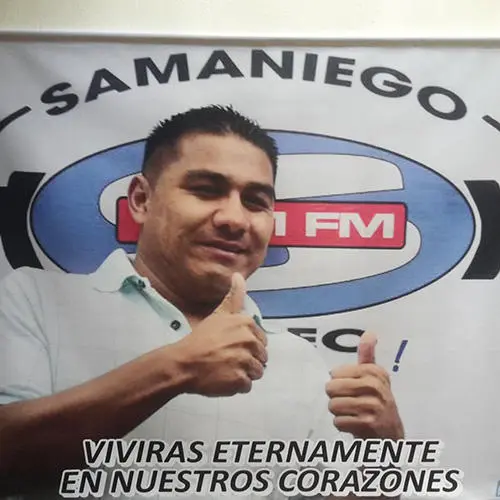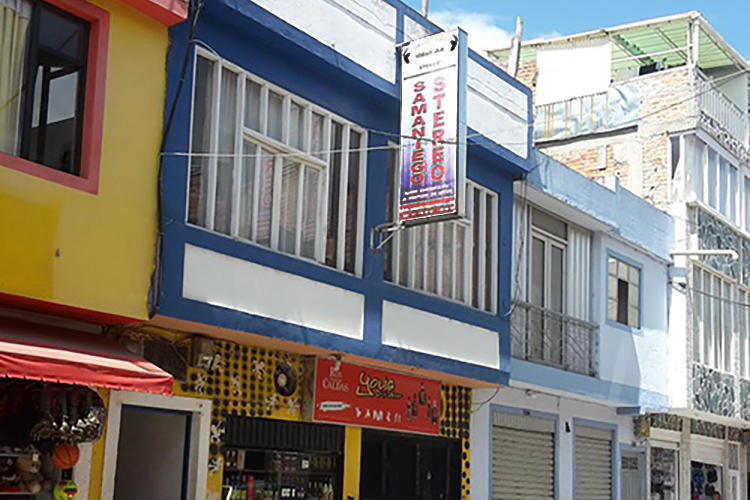The otherwise Spartan studio of Samaniego Stereo is adorned by a white banner emblazoned with the image of Libardo Montenegro, a veteran reporter for the community radio station in southern Colombia who was shot dead on June 11. Under his photo are the words: “You will live in our hearts forever.”
The killing, carried out by two gunmen on a motorcycle, has gone largely unnoticed in the rest of Colombia. But the crime has traumatized Samaniego, a mountainous town of 25,000 people in Nariño department, which borders Ecuador.
Hundreds of people attended the funeral of Montenegro, who had been a constant and reassuring voice on the airwaves for the past two decades. The motive for the killing remains murky, leaving local journalists skittish about doing their jobs and fearing that they too could become targets.
“We all wonder who is going to be next,” said Jairo Melo López, a journalist and member of the board of directors of the local TV station SATEL.
In CPJ’s 2018 Global Impunity Index, Colombia ranked among the countries with the worst records for prosecuting the killers of journalists. In early July, CPJ joined a delegation that included the Bogotá-based Foundation for Press Freedom (FLIP) and two U.N. human rights officials for a two-day trip to Samaniego to learn more about Montenegro’s case and any possible links between his work and his killing.

Samaniego’s mayor, the chief of police, and the public prosecutor either refused to speak to the delegation or did not show up for interviews. Several town officials who agreed to talk dismissed the killing as a “crime of passion” and questioned whether Montenegro was really a journalist.
One police officer, who requested anonymity because he was not authorized to give declarations, said he was “95 percent sure” that Montenegro’s killing had nothing to do with his work as a journalist.
However, local human rights activists, journalists, and others who were close to Montenegro say that overlooking his role as a journalist and an influential community spokesman would be a mistake. They believe his killing may be linked to Montenegro’s recent coverage and radio commentary about drug-fueled violence in Samaniego.
Leobar Ibarra, a Samaniego journalist, said he thinks drug gangs ordered the killing “to send a message to the townsfolk to keep quiet” about their business.

Montenegro, 42, was a radio lifer. His grandfather was one of the founders of the Samaniego Stereo, an independent station that broadcasts news, interviews, and music. Montenegro began volunteering in the studio as a child and later became one of the station’s main reporters, anchors, and narrators for ads and public service announcements.
Among the programs he hosted was “El Despertador” (“The Wakeup”), which aired weekdays from 6-10 a.m. For extra money, he worked as a camera operator for SATEL. At the time of his death, he was partnering with local business owners to open another radio station.
“That was his dream,” said Wilson Montenegro, Libardo’s older brother. “He wanted to run his own station.”
He described Montenegro as easy-going both as a person and as a journalist. While Montenegro cared deeply about his community, watchdog journalism was not his forte even though there was plenty to investigate–from local government corruption to drug trafficking.
Nariño department has long been one of the top cocaine-producing regions in Colombia, and authorities say that a variety of armed groups are fighting for control over drug production facilities and smuggling routes. The mountains surrounding Samaniego are speckled with fields of coca, the raw material for cocaine, as well as laboratorios where coca leaves are turned into powder cocaine.
Authorities say that among those involved in smuggling cocaine are dissident members of the Revolutionary Armed Forces of Colombia (FARC), the Marxist guerrilla group that disarmed under a 2016 peace treaty.
During the delegation’s visit to Samaniego, a FARC dissident group called the Oliver Sinisterra Front announced a campaign of “social cleansing” in Samaniego that would target everyone from petty thieves to government spies. This same group was responsible for the kidnapping and killing last year of two Ecuadoran reporters and their driver in Nariño.
Another guerrilla group, the National Liberation Army (ELN), operates in and around Samaniego. A red-and-black ELN flag was clearly visible in the mountains overlooking the town.
So far this year there have been 16 homicides in Samaniego, making it the second-most violent town in Nariño department, according to Paulo Ruiz, chief of staff at Samaniego town hall. Among the victims was Paula Ordoñez, the government human rights ombudswoman in Samaniego, who was killed by gunmen on May 20, another high-profile case that has yet to be solved.
In Nariño, “we have all the problems that you could ever ask for,” said Francisco Zarama, the government’s inspector general for the region who is based in the departmental capital of Pasto.
Montenegro often spoke out on the air against violence and drug use by local youths, and was a vocal supporter of the peace process that led to the disarmament of most of the FARC guerrillas. Shortly before his death, he got involved in a local human rights committee that was planning a march to protest recent murders in Samaniego.
Ibarra, who is also a committee member, told the delegation that he urged Montenegro to publicize the group’s activities. Montenegro recorded a spot promoting the march that ran on Samaniego Stereo during the six days preceding his death.
On the day he was killed, Montenegro broadcast a live interview with Ibarra on his morning program. During the interview, Ibarra energetically denounced drug-related violence in the town. One human rights activist in Samaniego, who requested anonymity over fear of being targeted, called it a “very strong interview” that may have angered drug trafficking gangs.
Ibarra told the delegation that he thinks traffickers ordered the killing of Montenegro “to send a message to the townsfolk to refrain from denouncing their activities.”
Adriana Romo, Montenegro’s girlfriend, agreed. “That could have been the reason,” she told CPJ in a telephone interview.
Romo, Ibarra, and others close to Montenegro said he had not mentioned receiving any threats. However, personnel at Samaniego Stereo told the delegation that on the day he was killed he was extremely nervous and proclaimed: “I am going to die.”
That evening, Romo took Montenegro, who was still feeling ill, to the hospital where he underwent an electrocardiogram and received muscle relaxants. After returning home that evening, Romo entered their apartment as Montenegro parked their car. Suddenly, shots rang out. Romo saw Montenegro lying in a gutter as two men on a motorcycle, who wore hoodies and facemasks, drove away.
“I tried to help him but it was too late,” Romo told CPJ.
Efforts by the delegation to speak with the public prosecutor’s office in Pasto, which is overseeing the case, were unsuccessful. But several sources in Samaniego said that the investigation is focused on Montenegro’s personal life rather than his work as a journalist.
Over the past six months, Montenegro had started living with Romo. She told CPJ that her former boyfriend was jealous of her relationship with Montenegro and that the two men had recently exchanged harsh words. But she refused to speculate on whether this could have been a factor in Montenegro’s death.
With the crime unsolved, self-censorship now grips Samaniego. López, the TV journalist, says he tones down his reporting “as a matter of survival.” Samaniego Stereo played religious music after Montenegro was killed and did not carry out its own investigation.
“We are not really sure how to handle the news right now,” said one of the station’s reporters, who requested anonymity. He added: “I’m scared to go out on the street because we don’t know why this happened.”
Reporting from Samaniego and Pasto, Colombia.
